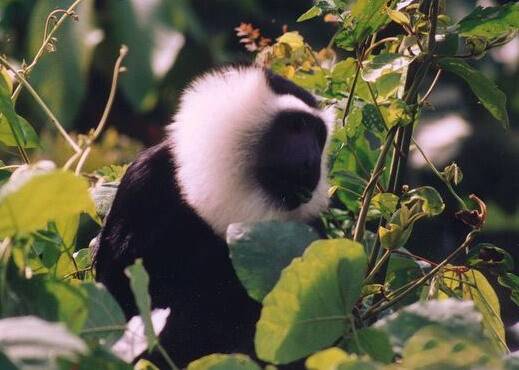Colobus vellerosus
IUCN
LCBasic Information
Scientific classification
- name:Colobus vellerosus
- Scientific Name:Colobus vellerosus,White-thighed Colobus、Geoffroy's Black-and-white Colobus,Jervis's black-and-white colobus
- Outline:Primates
- Family:Cercopithecidae Colobus
Vital signs
- length:61-66cm
- Weight:8.3-9.9kg
- lifetime:About 20 years
Feature
The coat is black and white, mainly black, with white beard
Distribution and Habitat
Distributed in Benin, Côte d'Ivoire, Ghana, Nigeria and Togo.
It inhabits lowland rainforests, deciduous forests and tropical grasslands, forest belts, and generally lives at an altitude of about 350 meters. It lives in the upper and middle layers of the forest and rarely comes to the ground.
Appearance
The piebald colobus monkey is 61-66 cm long for males and 61-64 cm long for females. Its tail is 75-81 cm long. The male weighs 9.9 kg and the female weighs 8.3 kg. It has a light body, slender limbs, and is larger and heavier than ordinary monkeys. Its anal warts are very small, and its fur is black and white, mainly black. The snow-white beard of this species forms a thick edge on the face. The beautiful and flowing tufted tail is white and longer than the body, more than 1 meter. The cheek pouches are also smaller than those of ordinary monkeys. The forelimbs have four distinctive fingers, and the thumb has degenerated into a small wart, so it is called a colobus monkey. The newborn monkeys have all white hair, which is in sharp contrast to the black hair of the adult monkeys.
Details
Colobus vellerosus (scientific name: White-thighed Colobus, Geoffroy's Black-and-white Colobus) was originally a subspecies of the West African black-and-white colobus and was confirmed as an independent species in 2003.

The family of spotted colobus monkeys is composed of multiple males and multiple females. There are an average of 16 members in a group, including up to four adult males, and the rest are females and young monkeys.
The spotted colobus monkey can mate and reproduce all year round. The marriage is polygamous or polyandrous. Female monkeys reproduce once every two years. The gestation period is 175 days. Each litter only produces one baby, and the baby monkey is white. In the first few months after the baby monkey is born, the female monkeys in the tribe will help take care of and support the baby monkey, regardless of whether it is the mother or not. The mother monkey takes the baby monkey everywhere to feed it. The baby monkey always hangs on its mother's chest and grasps the mother's fur. Living with the mother, the baby monkey grows the same color as the parents after 3 months. It can move freely at 7 months old and is sexually mature at around 4-6 years old. The average lifespan is 20 years old.
The threats to the spotted colobus monkey are mainly hunting, followed by habitat loss. The areas where they live are densely populated and growing rapidly, forest destruction has been extensive, and the hunting of wild animals is uncontrolled. These are the main reasons for the decline in the number of this species.
Listed in the 2008 Red List of Endangered Species of the World Conservation Union (IUCN) ver3.1 - Vulnerable (VU).
Listed in the CITES II level protected animals of the Washington Convention.
Protect wild animals and eliminate game.
Maintaining ecological balance is everyone's responsibility!








